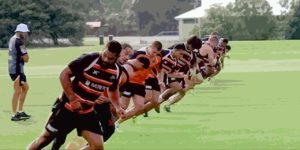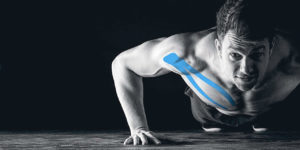Strong abs are a fitness must-have, but for rugby, they are much more than a fashion accessory. Strong abs will help stabilize and support your spine, increasing performance and reducing your risk of injury.
It doesn’t matter how strong your arms and legs are, if your abs are weak, you won’t be able to use that strength to full effect. As the saying goes, you can’t fire a cannon out of a canoe, meaning that weak abs will result in a mid-section collapse, and much of the force generated by your limbs will be lost.
So, how do most people try and strengthen their abs? The answer is often sit-ups and crunches. While there is nothing inherently wrong with these exercises, they are not very rugby-specific at all.
The cons of sit-ups
Sit-ups and crunches aren’t your best abs training choice for a several reasons…
- Low load – if you want stronger abs, you need to expose them to plenty of overload. Trying to strengthen your abs with sit-ups is like trying to build your legs with jogging
- Fixed range of motion – sit-ups work your abs in the sagittal plane, meaning forward and backward. In rugby, you need to have multidirectional abs strength, and that’s something sit-ups alone won’t develop
- High reps, low force production – in rugby, your abs not only need to provide stability and support over extended periods of time (endurance), they also need to generate explosive force very briefly (power). That means you’ll need more than sit-ups to build rugby-ready abs
- Sit-ups are done lying on your back – rugby is a standing sport, and even if you end up on your back, you won’t be there for long. Training your abs while lying on your back is about as far from rugby-specific as you can get!
This doesn’t mean you should discard sit-ups and crunches completely; they’re good exercises for developing local muscular endurance and using in workouts like conditioning circuits. However, if you want to develop abs that will enhance your rugby performance you need more than sit-ups.
And what about six-pack abs?
No abs discussion would be complete without mentioning six packs. A six pack is the combination of well-developed abs and a low level of body fat. Training is part of the six-pack puzzle, but so too is diet. Training for abs strength will develop thicker, denser abs, but you’ll also need to watch what you eat to reveal them to the world. Taking a low-carb approach to your nutrition is one way to attack this problem.
In fact, most of you reading this already have a six-pack; it’s just hiding under a layer of adipose tissue – that’s fat to you and me! Shed that fat and you too can have a six-pack. As the bodybuilders say, six-pack abs are made in the kitchen!
Abs exercises that are better than sit-ups
If you are serious about building rugby player abs, include these exercises in your strength training workouts. Keep the reps moderate to low, and look for ways to make the exercises harder over time, exactly as you would for any other type of training.
1) Pot stirrers
Planks are a popular abs exercise but, once you can maintain a good position for 60 seconds or more, they cease to be of much benefit – especially for increasing strength. Using a stability ball and incorporating movement, pot stirrers take the humble plank and make it more demanding and rugby-specific.
Place your elbows on a stability ball and move your feet back into the plank position. Brace your arms, abs, and legs to the max. Then, without relaxing, circle your elbows clockwise and counter clockwise.
See this exercise in action here:
2) High harness sled pulls
During rugby, you’ll often have to use your abs while you are on the move, for example, during a tackle. This exercise replicates the that demands rugby places on your abs, and will also develop posterior core strength.
Using a heavily loaded sled, hold the straps over your shoulders and then walk forward, dragging the sled behind you. Keep your abs braced throughout. Place the straps over one shoulder to add an element of anti-rotation to the exercise.
3) High to low cable wood chop
Most abs rotational exercises are all but pointless. Why? Because they fail to provide any meaningful overload. Twisting crunches and sit-ups are classic examples – there is next to no resistance to rotation, and broomstick twists are similarly ineffectual.
High to low (or low to high if you want some variation) wood chops are much more rugby-specific as a) there is plenty of overload, and b) they are performed from a standing position. You can perform this great exercise using a cable machine or resistance bands.
See it in action in this video:
4) Single arm farmer’s and waiter’s walk
Single limb or unilateral exercises are an effective way to develop rugby-specific strength. After all, rugby is often a one-side at a time activity. You can read more about single limb training for rugby in one of articles earlier this month.
Many unilateral exercises are also very good for developing strong, functional abs. When you have to support a load using just one arm or leg, your abs have to work overtime to keep your torso upright.
These two exercises are not just good for developing rugby player abs, they’re also good for grip strength (farmer’s walk) and shoulder stability (waiter’s walk) too. These are both central features of our off-season strength program.
- For the farmer’s walk, grip and hold a heavy dumbbell in one hand, and then walk around your training area.
- For the waiter’s walk, lift and hold a single dumbbell overhead. Keeping your straight, walk around your training area.
See the farmer’s walk in action in this video:
5) Medicine ball throws
Strong abs are one thing, but you also need powerful abs for successful rugby. Power is strength generated at speed, and can be developed with exercises such as the Olympic lifts and plyometrics. To develop powerful abs, medicine ball throws are hard to beat.
There are several medicine ball throwing exercises you can do – all of which are very rugby specific. Overhead throws, rotational throws, and medicine ball slams can all be used to develop abs power.
Whichever medicine ball throwing exercises you include in your workouts, make sure that each rep starts with a quick load, and an explosive unload. Think of medicine ball throwing exercises as plyos for your abs. Pay particular attention to this step if you’re looking to train for Hooker this season.
Boost your explosive throwing power with Pre-Game – the best rugby pre-workout supplement around.
Check out this video for some examples of medicine ball throwing exercises:
6) Saxon side bends
Arthur Saxon was a legendary strongman back in Victorian times. Famed for feats of strength that are still impressive today, this pocket rocket of a man had abs of iron. He developed his phenomenal abs strength with the exercise that now bears his name.
Press and hold a barbell overhead. Alternatively, use a weight plate, dumbbells, or a medicine ball. Stand with your feet shoulder-width apart. Without twisting your hips or shoulders, lean over to the left and then to the right. Start light – this exercise is harder than it looks!
Check out this video to learn how to do this exercise:
Make your abs training even more rugby specific
When it comes to abs training, if you do it in the gym, most of the time you’ll have complete control over your breathing. You’ll be able to time your breaths to match your movements, maximizing your performance of each and every exercise.
However, that’s not how things work in rugby!
During a match, you’ll have to use your abs to the max even if you are completely out of breath, huffing and puffing like and old steam train. No one is going to wait for you to get your breath back before tackling you, are they?!
It therefore makes sense that you should do at least some of your abs training in a very similar physiological state i.e. out of breath.
Replicate the demands of rugby by doing a set of abs after a brief bout of high intensity cardio. This will make your chosen exercise much more demanding, as well as more rugby specific. Use this method the next time you do interval training. Alternatively, superset abs work with other strength exercises e.g. squats and pot stirrers, bench presses and waiter’s/farmer’s walks.
As important as abs training is, they are just another muscle group and should be trained as such. There is no need to work your abs daily, or do hundreds of reps. Instead, focus on developing abs strength and power, just as you would for your legs, back, or chest. That’s how you get rugby player abs without sit-ups!


